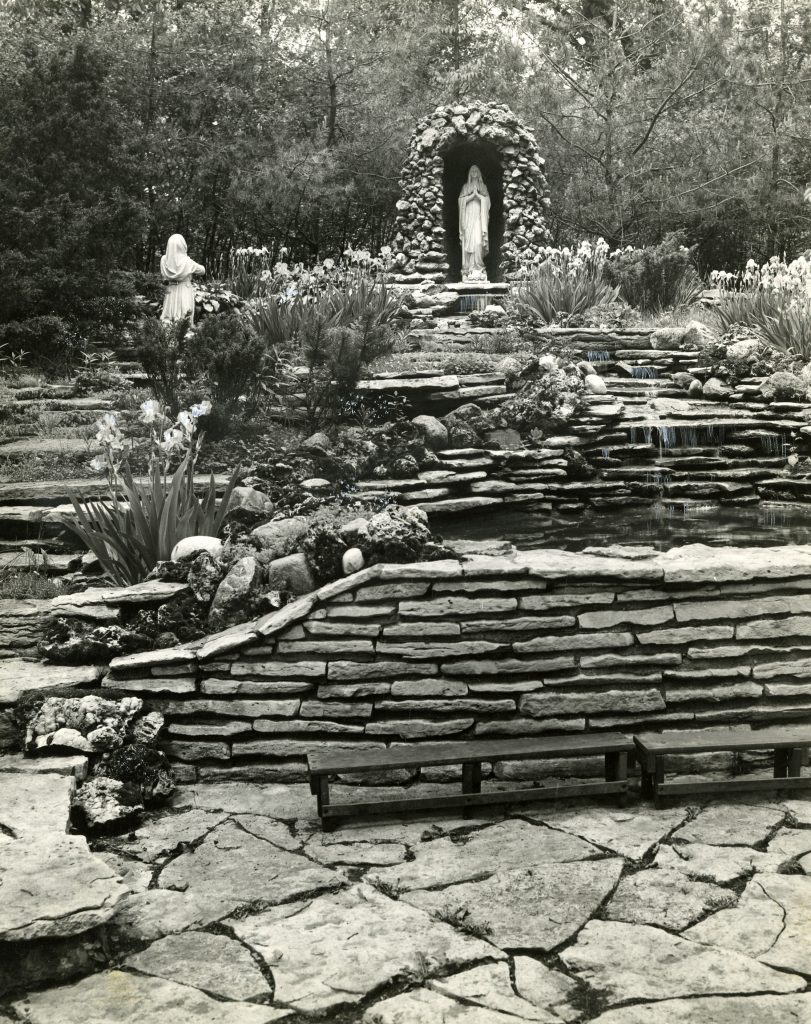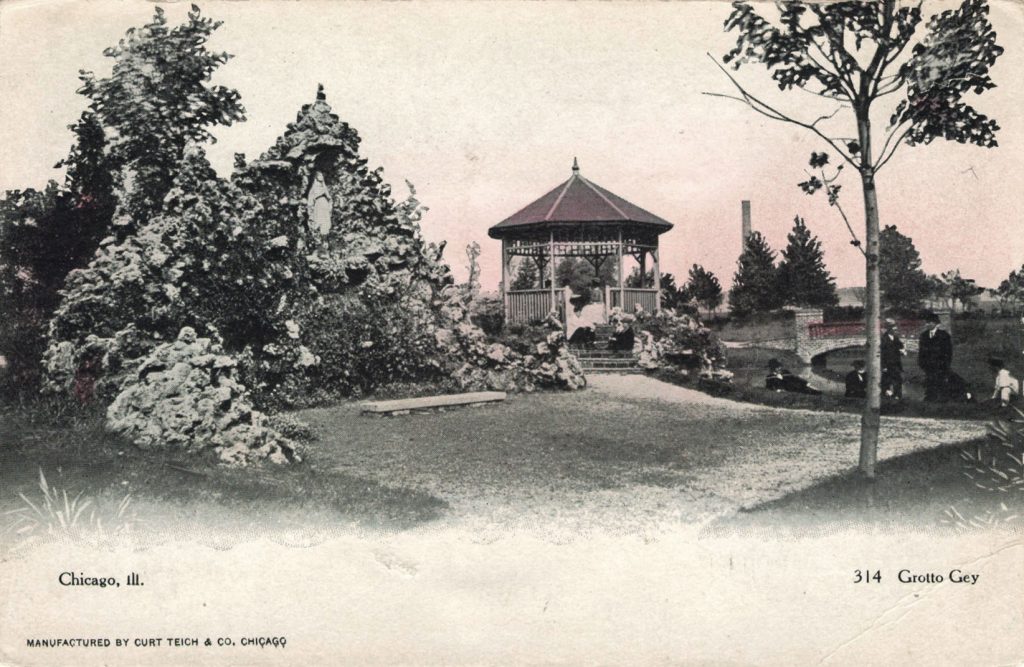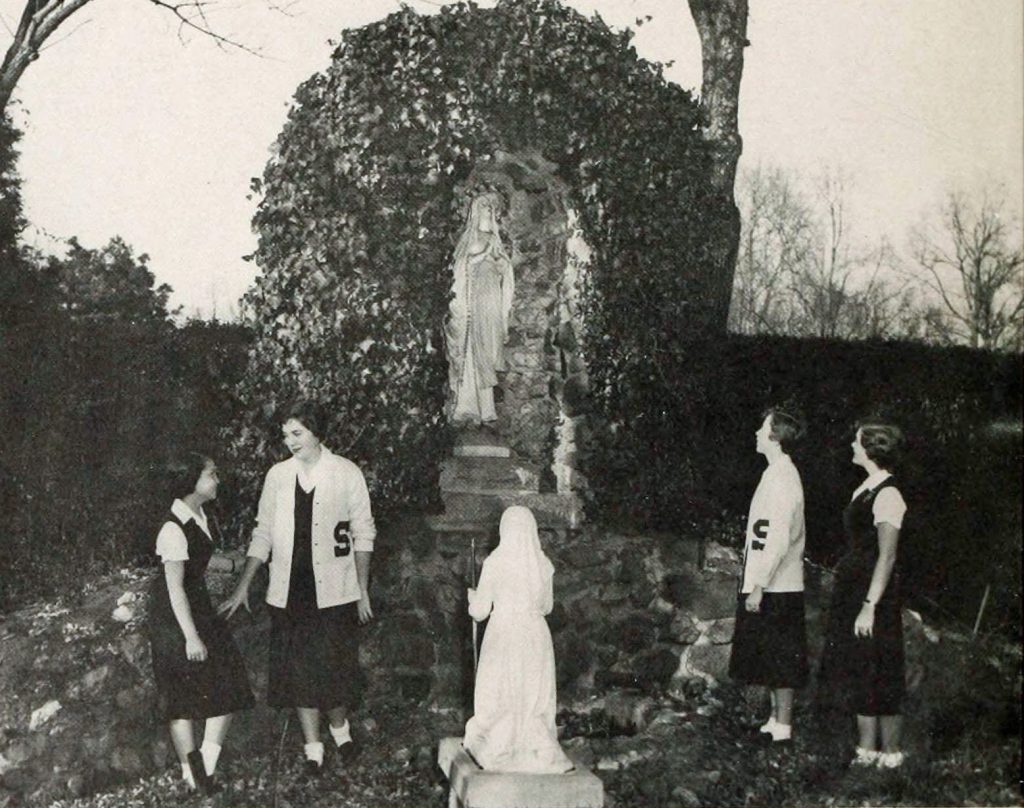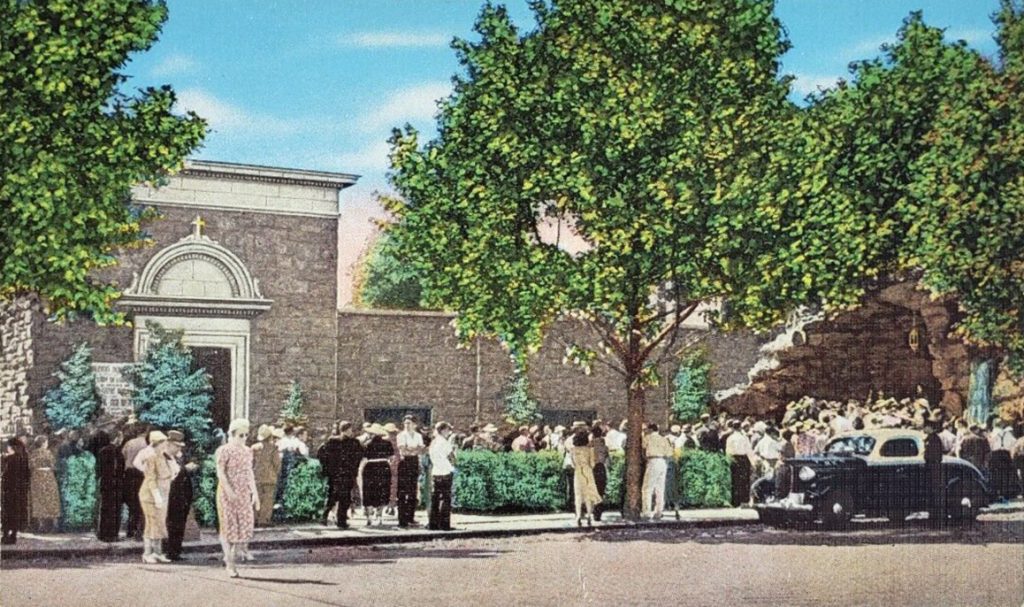About the Site

Thanks for stopping by my website, which documents and explores the meaning and artistic beauty of the many Lourdes grotto replicas built in the United States and Canada.
My background is as a garden historian who’s published books on the history of Iowa gardens and Midwestern Japanese gardens. My research centers on historical photos and postcard images of gardens, which I find beautiful and fascinating.
I became aware of Lourdes grottos when researching my book about T.R. Otsuka, a Midwestern Japanese gardener who lived in Chicago in the early 20th century (I believe he built a grotto, shown at right, on a Chicago-area university campus in 1929).
Despite my Catholic upbringing, I had no idea what the statues in that garden symbolized, and I wasn’t aware of the historical events surrounding Bernadette Soubirous’ 1858 visions of the Virgin Mary in Lourdes, France, until I looked them up on Wikipedia.
Wondering if Otsuka might have built any other grottos in the Chicago area, I looked on Ebay for postcards of Illinois grottos. I didn’t see any others that looked like his work, but I was amazed to discover that hundreds of postcard images of these beautiful outdoor religious spaces have been published.
I found myself deeply drawn to these evocative images and started collecting grotto postcards. They often sell for only a few dollars apiece on Ebay, and each picture tells a story about how we have encouraged religious faith and about our need for beauty. I wonder if postcards might have been partly responsible for spreading the idea of building grottos–most grottos were built between 1900 and 1960, coinciding with the popularity of postcards in the US (around 1905 through the 1950s). Also, postcard printing began as a German technology, and many US grottos seem to have been built by German Catholic immigrants. It doesn’t seem unreasonable that postcards, an inexpensive and highly popular way to communicate, might have let people know how beautiful grottos could be, and increased the desire to build them.

Most (but not all) Lourdes grottos are found in outdoor spaces, and many of them have been made more beautiful by planting flowers, shrubs and trees around them. Most Lourdes grottos are religious gardens.
Ornamental gardens represent ideas and desires: we plant the flowers our mothers or grandmothers planted because we want to remember them. Formal gardens represent order and nostalgia for perceived simpler times. Wild or prairie-style gardens symbolize a desire to return the earth to how it was before humans tried to order it.
The meaning of Lourdes grotto gardens is complex: their purpose was and is to encourage faith through their beauty and through the story they represent: the Lourdes visions, Bernadette’s unshakeable faith, and the miraculous healings at Lourdes over the past 150 years. The scene depicted by grottos allows us to imagine ourselves in Bernadette’s place: what if Mary chose to reveal herself to us? Would we be able to convince others of what we had experienced, and how would our lives change as a result?
The building of grottos at local institutions generated devotion and enthusiasm among their members, testified to by the hundreds of grotto postcards published by churches and other institutions. Today, Facebook posts about grottos at high schools or colleges receive numerous comments from alumni who mention their fond memories of these special places.

And the human stories associated with grottos are often dramatic. Some were built after a priest or church member made a vow to Mary to build a shrine to her if she would intercede to allow them to survive a perilous situation: a life-threatening illness; a harrowing battle aboard a warship; German concentration camps. Several grottos in the US have been associated with healings, and many more have been the sites of regular pilgrimage events with thousands participating.

Other grottos have existed privately behind convent walls, virtually unknown to the public, and never mentioned in newspapers or shown in photos.
It is haunting to see the remnants of grottos at decommissioned churches and shuttered convents, and sometimes historic photos are all that remain of these once-revered gardens of faith.

Grottos are indeed special places, ones worth preserving and visiting. In addition to their beauty, the stories of their history remind us that religious faith used to be a much larger part of most people’s lives than it is today, and they can show us how to be more faith-filled in the present.
I’m convinced that it was the beauty of Lourdes grottos, and the displays of faith I saw in these postcards and photos, that led me back to the Church.
This “way of beauty” (via pulchra), our natural desire for beauty that can never be truly fulfilled on earth, is a way to lead us to the perfect beauty of God. This has been remarked upon by great Catholic thinkers and evangelists from Saint Augustine to Saint Pope John II and many, many others.
Lourdes grottos are beautiful, and they are a truly accessible way for people to glimpse the beauty of faith, because they are mostly outdoors for everyone to see and visit. They can stimulate our longings for God, without (yet) needing to go into a church. They are a foot in the door, and for those firmly inside the Church already their beauty sustains our faith. Catholics should build more of them–and I believe they are!
I’m writing a book about Lourdes grottos that I hope to publish in a couple of years. In the meantime, I’m documenting these fascinating spaces in this website.
- First, I’m making pages about the Lourdes grottos I’ve found in each state (and will subdivide into state regions or dioceses for states with lots of grottos like New York and Pennsylvania.
- I’ll write separate posts for the Lourdes grotto I’ve found for which there is a lot of information. Some grottos were widely publicized in newspapers and postcards, and held annual pilgrimages, and may have published detailed descriptions about their construction: who, why, and how they were built.
- This process will take some time, as I’ve found more than 1,600 US grottos so far (and I will eventually add Canadian grottos too).
- If anyone knows anything about a grotto, I’d be grateful if you’d post a comment or contact me, sharing any information or personal stories you might have about it.
- And if a grotto you know about isn’t listed–especially new ones!–please let me know about it using the Contact page. Thanks!
I hope that people who want to know more about Lourdes grottos will enjoy the many beautiful images and find helpful the information about these special places.
And I particularly hope this website (and my book after it’s published) will be a resource for people who are planning to build grottos at their churches or schools, to make it easy to see images of the many various styles in which they have been built, and the landscaping around them. It’s time for a revival in the art of building beautiful grottos to honor and venerate Our Lady of Lourdes. It’s time to let their “way of beauty” lead more people to faith.
Thanks! -Beth